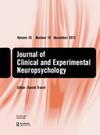Evaluating practice effects across learning trials - ceiling effects or something more?
IF 1.7
4区 心理学
Q3 CLINICAL NEUROLOGY
Journal of clinical and experimental neuropsychology
Pub Date : 2024-09-11
DOI:10.1080/13803395.2024.2400107
引用次数: 0
Abstract
BACKGROUND Practice effects (PE) are traditionally considered improvements in performance observed resulting from repeated exposure to test materials across multiple testing sessions. While PE are commonly observed for memory tests, this effect has only been considered in summary total scores. The current objective was to consider PE in summary total scores, individual learning trials, and learning slopes. METHOD One-week PE for individual trial and learning slope performance was examined on the BVMT-R and HVLT-R in 151 cognitively intact participants and 131 participants with Mild Cognitive Impairment (MCI) aged 65 years and older. RESULTS One-week PE were observed across all trials and summary total scores for both memory measures and diagnostic classifications, despite the potential for ceiling effects to limit improvement on retesting. PE were largest on the first trial relative to subsequent learning trials. This effect was diminished - but not eliminated - in participants with MCI. Conversely, no PE were observed for learning slope scores, which was counter to expectations and likely confounded by ceiling effects. CONCLUSIONS PE were present across learning trials but not learning slopes, and the initial learning trial at follow-up tended to benefit most from PE relative to subsequent learning trials. Ceiling effects appeared to influence PE for learning slopes more than learning trials. These results highlight the potential diagnostic utility of PE across individual learning trials and inform how they are distributed at follow-up, while also suggesting that learning slopes may be generally stable during longitudinal assessment.评估学习试验中的练习效果--天花板效应还是其他?
背景练习效应(PE)传统上被认为是在多次测试中反复接触测试材料而观察到的成绩提高。虽然在记忆测试中经常能观察到练习效应,但这种效应只在总分中得到考虑。结果 尽管天花板效应可能会限制重测时成绩的提高,但在记忆测量和诊断分类的所有测试和总分汇总中都观察到了一周PE。与随后的学习试验相比,第一次试验的PE最大。这种效应在患有 MCI 的参与者身上有所减弱,但并未消除。与此相反,在学习斜率得分方面没有观察到PE,这与预期相反,并可能受到天花板效应的影响。结论PE存在于学习试验中,但不存在于学习斜率中,相对于后续学习试验,随访时的首次学习试验往往从PE中获益最多。天花板效应似乎比学习试验更能影响学习斜坡的PE。这些结果凸显了PE对单个学习试验的潜在诊断作用,并为后续学习试验的分布提供了信息,同时也表明学习斜率在纵向评估中可能总体上是稳定的。
本文章由计算机程序翻译,如有差异,请以英文原文为准。
求助全文
约1分钟内获得全文
求助全文
来源期刊
CiteScore
3.20
自引率
4.50%
发文量
52
审稿时长
6-12 weeks
期刊介绍:
Journal of Clinical and Experimental Neuropsychology ( JCEN) publishes research on the neuropsychological consequences of brain disease, disorders, and dysfunction, and aims to promote the integration of theories, methods, and research findings in clinical and experimental neuropsychology. The primary emphasis of JCEN is to publish original empirical research pertaining to brain-behavior relationships and neuropsychological manifestations of brain disease. Theoretical and methodological papers, critical reviews of content areas, and theoretically-relevant case studies are also welcome.

 求助内容:
求助内容: 应助结果提醒方式:
应助结果提醒方式:


